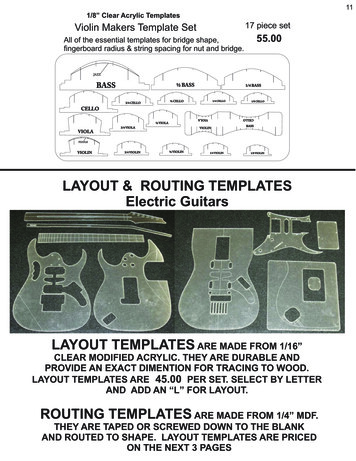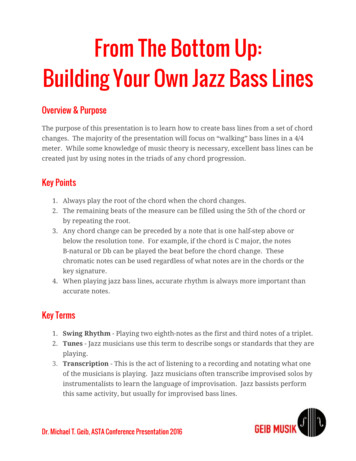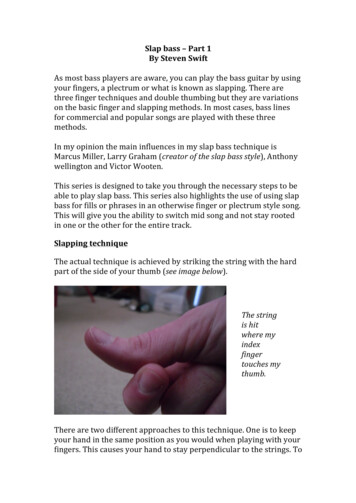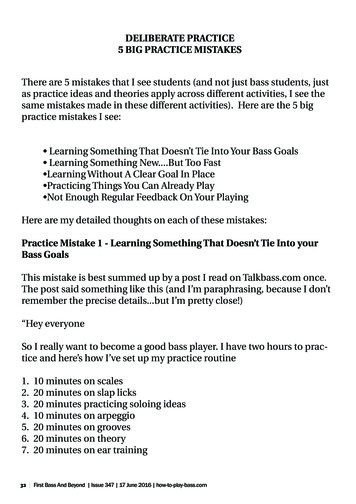
Transcription
OWNER’S MANUALFOR FENDER BASSES
Languages1Si necesita acceder a los manuales de instrucciones de las guitarras bajos en Español, visitenuestra página web http://www.fender.com/supportVous trouverez le mode d’emploi des guitares basses Fender en français sur le siteInternet http://www.fender.com/supportIl manuale d’uso dei bassi Fender in Italiano è disponibile nel nostro sito webhttp://www.fender.com/supportDas Fender Bedienungshandbuch für Bässe in Deutsch, finden Sie auf unserer Website http://www.fender.com/supportSe desejar ler o manual do proprietário Fender para baixos em português, por favor, visitenosso website em ギター用 Fender �ェブサイトhttp://www.fender.com/support をご参照ください。
Welcome to theFender FamilyCongratulations, you’ve just purchased a piece ofhistory from Fender Musical Instruments, the companythat brought the solid body electric bass guitar to theworld.Whether you are new to the bass or even if you’vebeen playing for years, this manual will give you all theinformation you need to take the mystery out of tuning,changing strings, setup, adjustment, intonation, care, andmaintenance of your bass. It’s easy! And once you’ve learnedhow to care for your bass properly, you’ll find that it will takegreat care of you too, by providing a wonderful vehicle foryears of fun, creativity, and musical self-expression.With that in mind, we hope you’ll take a few momentsto read through this entire owner’s manual. You’ll beglad you did!2
HistoryFrom the Beginning Fender---our very name is synonymous with all things bass. The electric bass guitar and the bassamplifier simply weren’t available to the masses before Clarence “Leo” Fender and his smallSouthern California company conceived of and produced the Precision Bass and the Bassman amplifier in the early 1950s.Throughout the 1930s and ‘40s, the upright bass, which was the standard in popular music at thetime, could barely be heard beneath the rumble and volume of the pop and big bands of the era. In1951 Fender changed all of that with the creation of the Precision Bass , an electric bass guitar with“precise” intonation that when amplified, could be easily heard and felt on the bandstands andthroughout the dance venues of the day, forever altering the landscape of popular and recordedMusic.3
HistoryIn 1960 Fender created another revolutionary instrument, the Jazz Bass . Withits offset waist, two pickups and narrow neck, the Jazz Bass was sonicallyversatile, faster playing, and soon became the standard by which all other bassguitars were measured.Fender basses became the most recorded basses on the planet and theypersist in dominating the catalogs of popular music today because theunique character of their voices has helped to define and shape the verystyles and genres of electric music we all love and listen to.Fender continues to be on the cutting edge of bass guitar developmentand offers a phenomenal selection of world class basses and bassamplifiers for everyone from the beginning player to seasoned touringand recording professionals.From James Jamerson to Geddy Lee to Jaco Pastorius to Marcus Miller, the Fender bass has been the vehicle of choice for themasters and innovators. With your new bass, the same opportunity to become a virtuoso is now in your hands.So, now that you have a brand new bass guitar, it’s time to strap it on, plug it in and Make History !4
History1951Precision Bass andBassman ampcreated19461954Fender founded byStratocaster Clarence Leonidasunveiled“Leo” Fender1950Telecaster andEsquire created51960Jazz Bass created1965Fender soldto CBSTimeline2000 Fender continues to innovate into thefuture1958mid-1980sJazzmaster quitarmodern-era Fendercreatedlaunched19621952 quitarJaguarThe Twin Amp createdcreated
6
Anatomy 101Anatomy7Whether you know the names of all the parts or not, anatomical charts arealways cool. Here’s the basic anatomy of a bass guitar:bodypickup polepickupspiecestrap djustmentscrewoutputjackvolume/tonecontrol knobsstringpickguardtruss rodadjustment(depending onmodel)
truss rodadjustment(depending onmodel)dot position inlayfrettuning machines(keys)fingerboardAnatomytuning machinepost (shaft)12th fret(octave) positioninlaynutstring tree(retainer)headstock8
9
You can always contact us directly to get this information as well, eitherby mail, telephone or e-mail:SpecsControls &For switch/control function diagrams, parts lists and wiring diagrams foryour specific model, visit the “Support” section of www.fender.com, wherethe “Wiring Diagrams/Parts Lists” link will take you to info several Fenderinstrument models.Attn: Consumer RelationsFender Musical Instruments Corp.8860 East Chaparral Road, Suite 100Scottsdale, Ariz. 10InfoFeaturesFor detailed info on the features and specifications of your bass guitar,visit the “Products” section of www.fender.com, where each individualbass guitar listing has a “Specs” link that’ll give you an easy-to-read list.
InfoUNDERSTANDING THE EFFECTS OF TEMPERATURE AND HUMIDITY Your bass has been constructed with the finest materials and processes available. As part of its final assembly, it has beenhand adjusted and set up to the Fender factory specifications, which produce the best possible playing action. However, thisinstrument, like all instruments made from wood, can be sensitive to fluctuations in temperature and humidity.The woods of your bass absorb moisture from the air when it is humid, and they evaporate moisture out when the humidityfalls. The wood also expands and contracts with changes in temperature. These natural movements are fairly minute, and whilegenerally not visible to the naked eye, they can dramatically affect the setup and playability of the instrument.On a hot day, for example, when an already-tuned instrument is taken from a hot car into a cool air-conditioned environmentand removed from its case, its woods cool and shrink fairly quickly. This contraction decreases the string tension and causesthe tuning to drop noticeably flat.These same aspects may come into play after an instrument leaves our factory and before you receive it from your Dealer. Theplaying action and setup of the instrument when you receive it will depend on several factors, such as: 11The amount of time between the final assembly and when the instrument actually ships from Fender.The amount of time taken during shipping for the instrument to travel from Fender’s warehouse to its final destination.The method of shipping the instrument, i.e. ground, air etc.The climatic conditions the instrument is exposed to during shipment.The climatic conditions of the shipping destination.The amount of time the instrument is in stock at your Fender Dealer before you receive it.Whether or not a product preparation setup has been performed on the instrument by your Dealer before you receive it.
DO NOT BE ALARMED IF, WHEN YOU FIRST RECEIVE THEINSTRUMENT, YOU FIND THAT THE PLAYING ACTION IS NOLONGER SET TO FACTORY SPECIFICATIONS. IT IS NATURALFOR THE SETUP TO CHANGE OVER TIME WHEN EXPOSED TOTHE FACTORS DESCRIBED ON THE PREVIOUS PAGE.Fender electric instruments have numerous points of adjustment thatwill allow you to compensate for the changes in the playing action thatmay have occurred between final assembly and when you receivethe instrument. If you find the action to be too high or too low for yourtaste or playing style, please review this manual for details on thesetup, adjustment, and maintenance that will return the instrument toan optimum playing condition for you.Please Note: Initial standard setup and adjustment of the instrumentand its components at the time of purchase are considered normalDealer product preparation and are not covered by the Fenderwarranty. Upon receipt and acceptance of the instrument, theconsumer assumes all responsibility for setups, adjustments, andmaintenance.12InfoIf you have any doubts in your ability to make these adjustmentscorrectly, take your bass to an Authorized Fender Service Center forassistance.
Great Electric Bass Guitar SetupWhile it is certainly possible to give your bass a great setup just using some basic tools and your eyeballs,we have found that the job is considerably easier with the right tools. For best results in changing strings andperforming setups and adjustments, we recommend using the tools listed below.Electronic tunerWire cuttersCapoSet of automotive feeler gauges (.002” - .025”)A 6” ruler (with 1/32” and 1/64” increments)A large Phillips screwdriver (Vintage Series basses), or the hex truss rod adjustment wrench thataccompanied your bass (modern basses) Mini flat-head screwdriver (Vintage Series basses), or the hex saddle height adjustmentwrench that accompanied your bass (modern basses)Set-up TUNINGIf you don’t own an electronic tuner, you may want to purchase one. It will simplify many of the followingprocedures. If you already have one, just plug in and turn the bass’s volume control all the way up. Pluckeither an open string or the 12th fret harmonic*, to produce the clearest tone for the tuner. (*A harmonic isa “chime-like” tone that is produced by lightly touching the exact mid point of the string at the twelfth fretwith your finger tip, and plucking the string with the other hand.) Note: If you press the string too hard, it willchoke the string and mute the sound. With a little practice though, you’ll develop the light touch needed tomake the harmonic ring out.13
If you’re playing a 4-string bass, tune the open strings to E, A, D, GEADGIf you’re playing a 5-string bass, tune the open strings to B, E, A, D, GEADGSet-upBIf you’re playing a 6-string bass, tune the open strings to B, E, A, D, G, CBEADGC14
Set-upChanging StringsA fresh set of strings can breathe new life into your bass, and something as simple as how you wind the strings onto the tuning machine postswhen changing your strings, will determine tuning stability and string tension. It’s also a good idea to stretch your strings a little as you tuneto make sure that each string is seated well and snugged down on the tuning machine post. This will save you some tuning frustration downthe road. Just grab the string in the middle, lightly tug it up and down to remove slack, and then retune. (See your Fender Dealer to obtainreplacement Fender bass strings.)First start by pulling each string through the bridge, over the nut and past the corresponding tuningmachine post, with enough extra length to allow a minimum of three winds around it. Mark that pointon the string. With wire cutters, crimp the string over at a 45-degree angle one inch before the mark,then clip off the excess at the mark, (Figure A).Next, place the end of the string all the way down in the hole in the center of the tuning machinepost and bend the string over in the slot. Wind the tuning key to tighten the string to pitch whileholding the loose end of the string in place with yourother hand, (Figure B). Make sure that the string doesnot overlap itself and is wound from the top down to thebase of the tuning machine shaft, to insure the string isseated properly on the nut with the most acute breakangle possible, (Figure C).15Figure BFigure AFigure C
Changing BatteriesFender produces basses with passive electronics (no batteries) and basseswith active (battery-powered) preamps. Some active basses have an active/passive switch, to switch between modes. Depending on the instrument, youractive bass may have either a 9-volt (one-battery) system, or an 18-volt (twobattery) system. (Visit the Fender website for detailed specifications for yourinstrument.)As your batteries lose their power, the voltage supplied to the preamp willalso drop, which will result in distortion and noise in the bass’s signal. Whendistortion and noise occur in your signal, it is your cue that the batteries mustbe changed for the instrument to operate correctly. Note: Active basses thatdo not have an active/passive switch will not play passively when the batteriesare dead.For basses with 2-battery 18-volt preamps, always replace both batteries atthe same time, as mismatched voltages may adversely affect the performanceof the preamp. It is a good idea to use the same brand of battery consistently,over the life of the instrument.Weather, specifically temperature and humidity, may have adramatic impact on the way your bass plays. All instrumentwoods expand and contract with seasonal fluctuations intemperature and humidity, and naturally, string height andplaying action are affected. Depending on the climate where youlive, your bass may need routine adjustments a couple of timesa year.Fender basses have several points of adjustment whichare there to compensate for the adverse effects of theseenvironmental changes, and more importantly, these featuresallow you to tailor the playing action of the bass to your ownpersonal playing style.Note: The following factory specifications are median specs,and are meant only to guide you. They should not be taken ashard and fast rules. If you prefer your action a little higher orlower, change it as you like, but be aware that higher action willbe more difficult to play and lower action may result in excessivefret buzz, depending on your technique, or style of play.16Set-upTypical battery life for both systems is approximately 600 hours of playing time.All Fender basses with active preamps are equipped with switching jacks whichengage the battery when a cable is plugged into the jack. Note: To maximizebattery life, unplug your cable from the bass when not playing the instrument.Setup and Adjustment Made Easy
The following setup procedures and specifications are for your Fender bass as equipped with thestrings that come on the instrument as standard equipment from the factory. If you plan to changestring gauges, you
In 1960 Fender created another revolutionary instrument, the Jazz Bass . With its offset waist, two pickups and narrow neck, the Jazz Bass was sonically versatile, faster playing, and soon became the standard by which all other bass guitars were measured. Fender basses became the most recorded basses on the planet and they persist in dominating the catalogs of popular music today because the .










